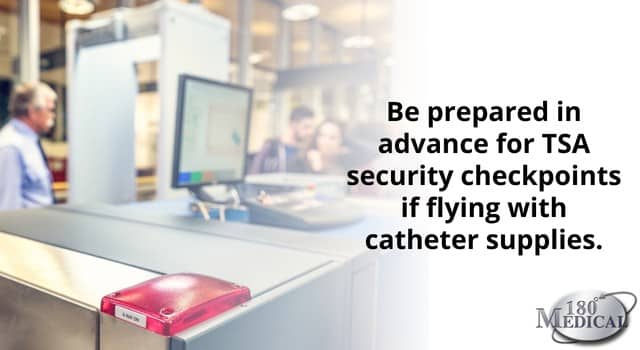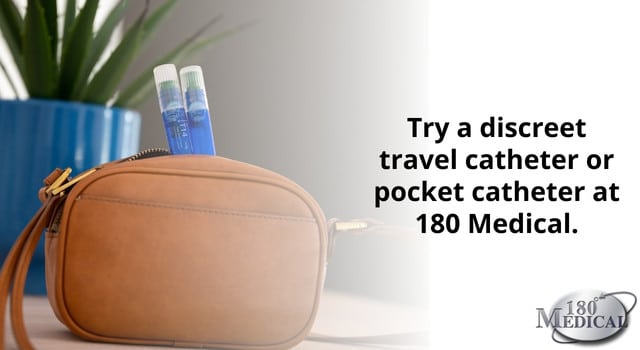
Flying with urinary catheters can be a bit intimidating, especially for people who are new to cathing. Here are some of our top tips for traveling by air with your catheter supplies.
Top Tips for Flying with Catheters
1. Contact the Airline
One of the first things to do is to contact the airline you will be traveling with and inquire if the airline has any special procedures for traveling with catheters. The airline should advise of procedures you should follow. Ask if the equipment you bring onboard meets Transportation Security Administration (TSA) guidelines and follow some basic hygiene steps during the flight.

2. Know the TSA’s Carry-on Bag Regulations
TSA has established air travel laws and regulations on liquids. For carry-on bags, place all liquids of 3.4 oz or less in one clear plastic quart bag.
If you have lubricant, make sure it is 3.4oz or less and goes in a clear plastic bag. The airline should be okay with those who use lubricant with their catheters, as it is required to catheterize. You should not be limited to how much you can take, but keep it with your catheters so it will be more apparent what it is used for.
3. Bring Extra Catheters
Count the number of catheters you need for your trip depending on how often you catheterize and how many days you will be gone. It is a good idea to take enough catheters to last a few extra days in case of unforeseen circumstances. This also includes lubricating jelly and any other supplies you use to catheterize.

If you plan an extended stay at your destination, contact 180 Medical. We can ship your supplies to your destination as long as it is anywhere in the United States, including Hawaii and Alaska.
Shipping your supplies will help free up space in your suitcase for clothes, souvenirs, and gifts. Plus, you will know you have the supplies you need when you need them without worrying about your luggage getting lost or delayed.
5. Consider Travel Catheters Like Closed Systems and Compact Catheters
Many people prefer to use a more advanced catheter while traveling to reduce the chance of getting an infection. These pre-lubricated catheter kits do not require additional lubricating jelly, and you don’t have to touch the catheter tube directly. They are sometimes known as “no-touch” catheters, although most people call them closed-system catheters. If your insurance does not cover advanced catheter products, consider purchasing some for traveling.
Plus, when you’re away from home, you can’t always guarantee the sterility of your environment. You’ll likely be cathing in public restrooms. Using antiseptic wipes to clean your urethral area and your hands may be a good idea to help prevent UTIs.
 Often, travel catheters also include insertion supplies like antiseptic wipes and gloves to reduce the risk of UTIs.
Often, travel catheters also include insertion supplies like antiseptic wipes and gloves to reduce the risk of UTIs.